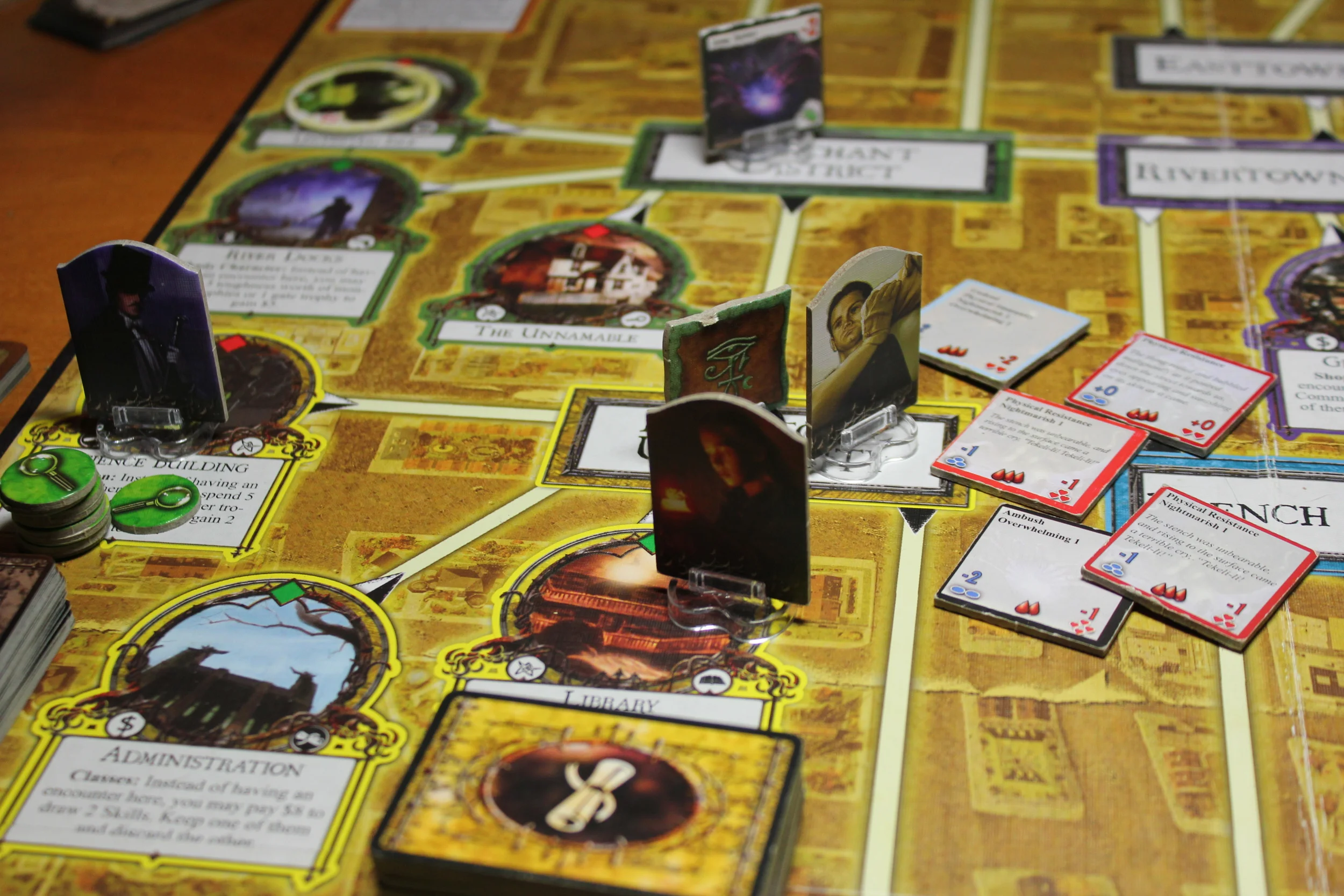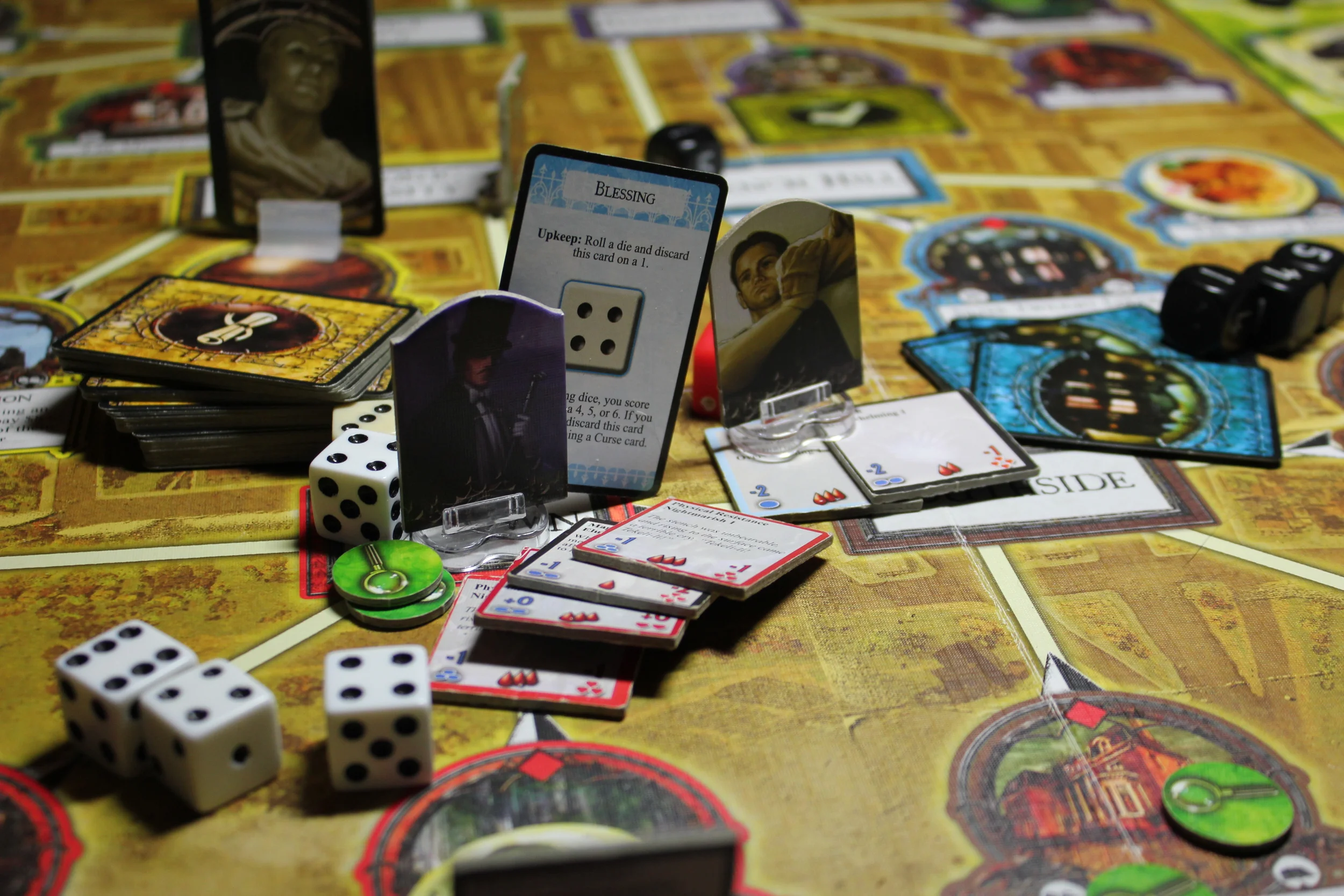Cairo Horror Beta-Test: Fan Expansion for Arkham Horror
Jenny Barnes arrives in the heart of the Egyptian capital of Cairo in pursuit of the Brotherhood of the Black Pharaoh.
Craving a good and engaging game, UB and BT sat down to have a go at the new AH expansion by UB based on the Egyptian capital of Cairo. We are planning using this expansion as part of a campaign, along with new characters and several other players, so we decided that this particular game would be a test drive.
The last time we played Cairo Horror, indeed the only other time we have played it, UB, BT and JT spent hours combing through the minutiae of rules and conflicts with existing rules. Despite de-powering the Djinn, the town of Arkham remained so busy, that only one of us got to even visit Cairo. This time would be different.
OBJECTIVE: Play through as many Cairo elements as possible. Agreed to bend and twist the through-line of the game if it was hampering access to Cairo. Rather than try and figure out the complex solutions to every problem, we'd simply note them down and play through them, or create a quick make-do suggestions to keep the game flowing.
We played a 'double hander', of four investigators between two players.
OBSERVATIONS:
1) Arkham needs to be down-powered.
The simple act of sending one investigator over to Cairo put pressure on defending Arkham. We were rapidly overwhelmed. Admittedly, we started the game with only only Dexter having one weapon (Shrivelling) and sent Jenny off to Cairo with all the money to buy gun.
Nevertheless, the Cairo Horror expansion is so big, and so engaging, the time spent jumping into Other Worlds, and fending off the monsters with a reduced team is too much. The issue is that Unlike other expansions, Cairo Horror assails the Arkham town directly and immediately (whereas the Rift tokens only appear later in Kingsport, or the Dunwich Horror only arrives later...)
It was realised that, rather than down-power the expansion, perhaps Arkham itself could be down powered so that all investigators could go to Cairo,
Solution: Rather than the first gate opening being used as the vortex to Cairo, it remains only the principle gate. Following that, ALL other gates also lead to the Cairo Vortex.
In effect, and unlike the other expansions which are accessed by conventional travel, Cairo serves the same role as an Other World, only it take an entire game rather than 3 turns to resolve. Because it is in part Nyarlathotep as the Dark Pharoah, incarnating and attacking the world from Cairo, he is dominating the influx of mythos related forces, and is particularly assailing Arkham because his agents are trying to secure artifacts from the Exhibit.
This way, all roads lead to Cairo, and no gates can be closed/sealed without completing the Cairo Horror expansion. Completing the Cairo board means sealing any open gates, and potentially winning the game.
2) Cairo Horror is much bigger than other board expansions. We feel it might be worth treating the Cairo Horror expansion as if two expansion boards were being played, in regards to adjusted Monster Limits etc
Solution: Treat the game as if it were two board expansions.
NOTABLE MOMENTS IN THE GAME
The game began with a Valentines theme. We picked two characters, and potential partners. UB ended up with Dexter Drake and Jenny Barnes, and BT had Hank Samson the Farmhand and Sister Mary the Nun. The former were immediately envisioned to both be part of the upper echelons of society, while the latter, were low level humble 'givers'. This was confirmed by them becoming Mystical Knights, while Dexter and Ms Barnes were collectors. On this latter point, it was considered that Jenny was basically a rich, bored groupie, who would furnish him with whatever trinkets he desired. As I have said before, adding these character themes and backstories help the players invest in the character, adding to the drama, such as this:
By 4 on the Doom Track, because we had not been able to kill ANYTHING, and because of the influx of monsters from the Cairo Vortex arriving in Arkham (not counting against the monster limit) the whole town became gridlocked. It was terribly terribly hard. Unrelentingly grim. Every single of the Arkham monsters were really hard 'big fights' like Dholes and Star Spawn, and Shoggoths (we play 'big games' with a Monster Cup of all monsters, except Masks played as usual - just because it is way too tiresome to figure out what monster went where) .
Extremely hard if the best weapon you have is a Shrivelling and a Holy Water followed by a cross in your party of four.
Hank wades in: Wraith, Leng Spider, Shoggoth, Shoggoth, Proto-Shoggoth.
Then there was the rumor. The Terrible Experiment: The one about fighting a bunch of monsters, which are added to every subsequent Mythos. And we had no weapons. And they were all horrid monsters. Not a maniac, child of the goat or cultist among them. Just utter horror. But we knew if had to be resolved, or we would, very soon face a Terror Track raised from 1 to 10, and no monster limit.
Hank dived in and was supported by Dexter in the adjacent Science Building, granting a plus from their Best of Friends relationship. Planning on taking as many as possible, Hank launched into his frenzied attack against the first opponent: a Wraith.
The unique ability is to delay the Horror check until he has failed his combat. Given this, Hank had entered the fray with the confidence of a man not planning on losing the combat, had his fight bumped up to its max of 5.
His combat was 12 dice (14 -2) for three toughness of hits.
He got a single hit out of all 12 dice. Shocked at losing the combat, Hank had to pass his Horror Check. With a roll of zero, he took all of the damage on the chin and settled for a rematch.
12 dice again, but this time Hank threw in all 7 of his clues (being saved for a gate seal), his Best of Friends bonus, and some other stuff I can't recall, and finally nailed all three successes he needed.
The fight had not gone to plan.
The next fight came along: a Leng Spider. A short but risky fight, resolved before he had to retire.
In the next turn, Hank retreated and Dexter stepped up, armed with his now delightful brass knuckles, his +1Fight skill, Voice of Ra for +1s, and his newest bestest buddy Tom Murphy (+2Fight). His base fight had been maxed to ensure the highest Will for his Horror Check, leaving him with +1 on that, for a total Combat figure of 5, minus whatever the monsters had. He had five clues.
Only, Hank had not merely run off in shame, but had run to his only place of refuge, the Southside Church, and there, with all of his Monster Trophies, he prayed for Dexter to be Blessed.
A now pumped up and divinely inspired Dexter wadded in. Ripping off his Shrivelling killed the first monster before it was exhausted. From then on his fists happened, as he scraped through fight after fight, until the gory entrails of all the remaining monsters began to congeal about the hemline of his fine trousers. Somewhere in the viscera the players could make out the remains of 2 Shoggoths, a Proto-Shoggoth, devouring Shan and a Leng Spider.
Dexter Drake almost always the unbidden 'man of the match' out did himself yet again.
If only the rest of the game was so pleasant...
We were playing for almost 11hours, and it was late in the morning by the time we finished, our sanity in tatters.
The Best of Friends pose for a quick team photo after clearing the rumour in two turns, killing 6 monsters for a total of 15 blood points.
When the final fight against the Ancient One Nyarlethotep arrived, as we by now chewed our way through the Doom Tokens we decided to pimp Dexter as much as possible. At his side stood Tom Mountain Murphy, with Professor Armitage delivering his +2Lore AND his Ignores Magical Resistance. His Shrivelling (+6) was aided by his Brass Knuckles (+1), an Alien Device (+2), Tom (+2), and his base Fight maxed (+4). Also he was blessed.
There was clearly a bunch of other stuff, because he did 16points of damage with his first hit. The rest was a formality, with now Battle Conditions, and us surviving two Sinister Plot cards... epic all the way.










